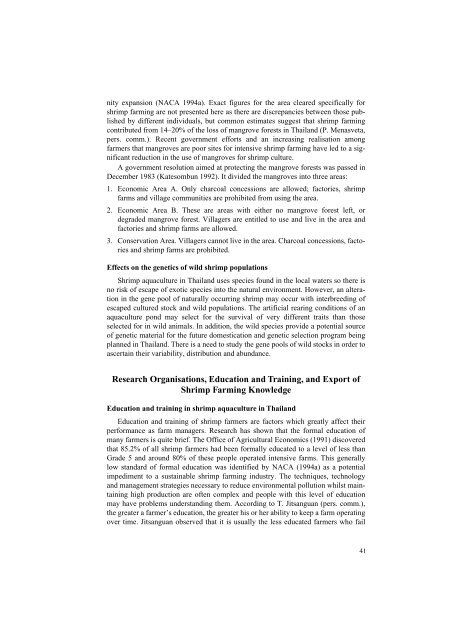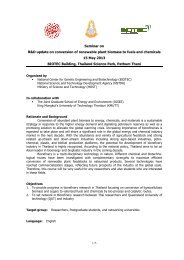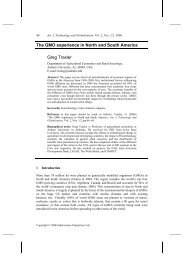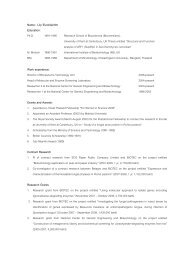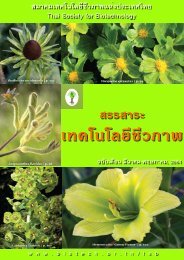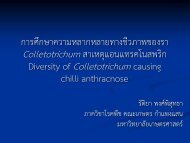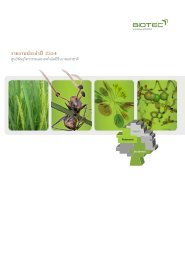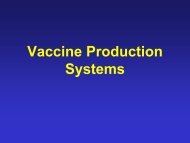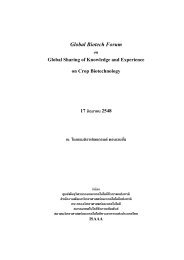Land subsidence<strong>Coastal</strong> land subsidence has been reported <strong>in</strong> the Philipp<strong>in</strong>es (Primavera 1989)and <strong>in</strong> Taiwan (Chiang and Lee 1986) as a result of the extraction of fresh water fromunderground aquifers <strong>for</strong> shrimp farm<strong>in</strong>g. However, there are no recorded <strong>in</strong>cidencesof land subsidence <strong>in</strong> <strong>Thailand</strong> which can be directly attributed to shrimp farm<strong>in</strong>g.Impact on fisheriesPopulations of many mar<strong>in</strong>e organisms are subject to natural fluctuations and areaffected by a diverse range of human activities. It is there<strong>for</strong>e difficult to identify orquantify the effects of shrimp farm<strong>in</strong>g on <strong>Thailand</strong>’s fisheries.The fish catch <strong>in</strong> the major rivers, canals and swamps is decl<strong>in</strong><strong>in</strong>g because of<strong>in</strong>creased fish<strong>in</strong>g pressures, <strong>in</strong>effective en<strong>for</strong>cement of regulations govern<strong>in</strong>g fisherieshabitats, and the environment—through environmental degradation, loss of floodpla<strong>in</strong>area and destruction of fish habitats (DOF 1994). Demersal fisheries <strong>in</strong> the Gulfof <strong>Thailand</strong> and the Andaman Sea are decl<strong>in</strong><strong>in</strong>g also, as a result of over-exploitation.Pelagic fisheries have <strong>in</strong>creased production over the last 20 years due to improvedcapture methods, but at present most are fully exploited and are beg<strong>in</strong>n<strong>in</strong>g to showsigns of stock depletion (DOF 1994).It is clear that there is a need <strong>for</strong> research on the <strong>in</strong>teractions between fisheriesand shrimp aquaculture, and <strong>in</strong>to develop<strong>in</strong>g suitable alternative feed componentsthat will reduce the requirement <strong>for</strong> fish or fish products <strong>in</strong> aquacultural feeds.Changes <strong>in</strong> coastal configurationIn some areas of <strong>Thailand</strong>, some shrimp farm development has changed thecoastal configuration, a consequence of the removal of mangrove <strong>for</strong>est and the subsequentexposure of <strong>in</strong>tertidal zones to the erosive potential of w<strong>in</strong>d and wave action.Additionally, water <strong>in</strong>take <strong>in</strong>stallations on jetties alter the natural flow of sea currentscaus<strong>in</strong>g some changes <strong>in</strong> local sedimentation and erosion (Boromthanarat 1994).Changes <strong>in</strong> habitatMost literature consider<strong>in</strong>g the loss of habitat <strong>for</strong> shrimp farm development dealsexclusively with mangrove loss. However, some wetlands have also been lost to shrimpdevelopment. Piamsomboon (1993) stated that 5.9% of shrimp farms were on landdescribed as previously ‘unproductive’, a proportion of which was probably wetlands.Mangrove <strong>for</strong>ests are known to be important to coastal ecology, provid<strong>in</strong>g nurseryareas <strong>for</strong> species of shrimp, crab and fish, many of which are commercially important.Mangrove <strong>for</strong>est <strong>in</strong> <strong>Thailand</strong> conta<strong>in</strong>s at least 68 species of plants, 72 species of fish, 54species of crab, 20 varieties of mollusc, 88 bird species (both migratory and residential),35 species of mammals and 25 species of reptiles (OECF 1992).Some mangrove <strong>for</strong>ests were cleared <strong>for</strong> shrimp farm<strong>in</strong>g dur<strong>in</strong>g the early expansionof extensive farm<strong>in</strong>g, but little is known of the orig<strong>in</strong>al state of this <strong>for</strong>est, and itis clear that shrimp farm<strong>in</strong>g is only one of the contributors to the loss of mangroves <strong>in</strong><strong>Thailand</strong>. The total mangrove area <strong>in</strong> 1961 was 2,299,375 rai; by 1989 it was reducedto 1,128,497 rai, a rate of destruction of 1.82% per year. Most of this occurredbetween 1980 and 1986 when extensive shrimp farm<strong>in</strong>g expanded. Apart fromshrimp farm<strong>in</strong>g, reasons <strong>for</strong> de<strong>for</strong>estation <strong>in</strong>cluded salt farm<strong>in</strong>g, m<strong>in</strong><strong>in</strong>g and commu-#*
nity expansion (NACA 1994a). Exact figures <strong>for</strong> the area cleared specifically <strong>for</strong>shrimp farm<strong>in</strong>g are not presented here as there are discrepancies between those publishedby different <strong>in</strong>dividuals, but common estimates suggest that shrimp farm<strong>in</strong>gcontributed from 14–20% of the loss of mangrove <strong>for</strong>ests <strong>in</strong> <strong>Thailand</strong> (P. Menasveta,pers. comm.). Recent government ef<strong>for</strong>ts and an <strong>in</strong>creas<strong>in</strong>g realisation amongfarmers that mangroves are poor sites <strong>for</strong> <strong>in</strong>tensive shrimp farm<strong>in</strong>g have led to a significantreduction <strong>in</strong> the use of mangroves <strong>for</strong> shrimp culture.A government resolution aimed at protect<strong>in</strong>g the mangrove <strong>for</strong>ests was passed <strong>in</strong>December 1983 (Katesombun 1992). It divided the mangroves <strong>in</strong>to three areas:1. Economic Area A. Only charcoal concessions are allowed; factories, shrimpfarms and village communities are prohibited from us<strong>in</strong>g the area.2. Economic Area B. These are areas with either no mangrove <strong>for</strong>est left, ordegraded mangrove <strong>for</strong>est. Villagers are entitled to use and live <strong>in</strong> the area andfactories and shrimp farms are allowed.3. Conservation Area. Villagers cannot live <strong>in</strong> the area. Charcoal concessions, factoriesand shrimp farms are prohibited.Effects on the genetics of wild shrimp populations<strong>Shrimp</strong> aquaculture <strong>in</strong> <strong>Thailand</strong> uses species found <strong>in</strong> the local waters so there isno risk of escape of exotic species <strong>in</strong>to the natural environment. However, an alteration<strong>in</strong> the gene pool of naturally occurr<strong>in</strong>g shrimp may occur with <strong>in</strong>terbreed<strong>in</strong>g ofescaped cultured stock and wild populations. The artificial rear<strong>in</strong>g conditions of anaquaculture pond may select <strong>for</strong> the survival of very different traits than thoseselected <strong>for</strong> <strong>in</strong> wild animals. In addition, the wild species provide a potential sourceof genetic material <strong>for</strong> the future domestication and genetic selection program be<strong>in</strong>gplanned <strong>in</strong> <strong>Thailand</strong>. There is a need to study the gene pools of wild stocks <strong>in</strong> order toascerta<strong>in</strong> their variability, distribution and abundance.<strong>Research</strong> Organisations, Education and Tra<strong>in</strong><strong>in</strong>g, and Export of<strong>Shrimp</strong> Farm<strong>in</strong>g KnowledgeEducation and tra<strong>in</strong><strong>in</strong>g <strong>in</strong> shrimp aquaculture <strong>in</strong> <strong>Thailand</strong>Education and tra<strong>in</strong><strong>in</strong>g of shrimp farmers are factors which greatly affect theirper<strong>for</strong>mance as farm managers. <strong>Research</strong> has shown that the <strong>for</strong>mal education ofmany farmers is quite brief. The Office of Agricultural Economics (1991) discoveredthat 85.2% of all shrimp farmers had been <strong>for</strong>mally educated to a level of less thanGrade 5 and around 80% of these people operated <strong>in</strong>tensive farms. This generallylow standard of <strong>for</strong>mal education was identified by NACA (1994a) as a potentialimpediment to a susta<strong>in</strong>able shrimp farm<strong>in</strong>g <strong>in</strong>dustry. The techniques, technologyand management strategies necessary to reduce environmental pollution whilst ma<strong>in</strong>ta<strong>in</strong><strong>in</strong>ghigh production are often complex and people with this level of educationmay have problems understand<strong>in</strong>g them. Accord<strong>in</strong>g to T. Jitsanguan (pers. comm.),the greater a farmer’s education, the greater his or her ability to keep a farm operat<strong>in</strong>gover time. Jitsanguan observed that it is usually the less educated farmers who fail#)
- Page 8 and 9: !The 1994 Workshop had a working hy
- Page 11 and 12: !The Workshop at Hat Yai, SongkhlaA
- Page 13 and 14: !ReferenceSmith, P.T., ed.. 1999. T
- Page 15 and 16: !Shrimp Farming in ThailandOver the
- Page 18 and 19: ! !Table 1. World production (# 1,0
- Page 20 and 21: !Domestic and world demandJapan is
- Page 22 and 23: !Intensification of farms has been
- Page 24 and 25: !no significant difference between
- Page 26 and 27: !Production Practices and Technique
- Page 28 and 29: !use water which is almost fresh (F
- Page 30 and 31: !mended quantities for application
- Page 32 and 33: !the biological processes in sedime
- Page 34 and 35: !factors (Fegan 1994). Environmenta
- Page 36 and 37: !Acid sulphate soils occur in most
- Page 38 and 39: during the rainy season, some deter
- Page 42 and 43: first when an area becomes environm
- Page 44 and 45: !Administration. Their work has inv
- Page 46 and 47: agriculture, selects coastal land p
- Page 48 and 49: Sustainability, Sustainable Develop
- Page 50 and 51: cultural and environmental asset va
- Page 52 and 53: $+Table 12. (cont’d) Impediments
- Page 54 and 55: $#Table 12. (cont’d) Impediments
- Page 56 and 57: $%Table 12. (cont’d) Impediments
- Page 58 and 59: capacities of alternative organisms
- Page 60 and 61: sources. This is one of the greates
- Page 62 and 63: Table 13. (cont’d) Summary of the
- Page 64 and 65: Boonyapiwat, S. 1989. Species of ph
- Page 66 and 67: Katesombun, B. 1992. Aquaculture pr
- Page 68 and 69: Sirisup, S. 1988 Socio-economic cha
- Page 70 and 71: !In the preliminary analysis, the s
- Page 72 and 73: !until all variables had been teste
- Page 74 and 75: !quality problem over the past 3 ye
- Page 76 and 77: !Figure 1. Characterisation of prov
- Page 78 and 79: !Variables Contributing to Shrimp P
- Page 80 and 81: !Figure 5. Relationship between ave
- Page 82 and 83: !southern). The linear regression m
- Page 84 and 85: !Appendix. Results of logistic regr
- Page 86 and 87: !2) Trat ProvinceClassification tab
- Page 88 and 89: !Chi-square df significanceModel Ch
- Page 90 and 91:
!8) Satun ProvinceClassification ta
- Page 92 and 93:
!Variables in the equationConstant
- Page 94 and 95:
!A total of 49 participants were in
- Page 96 and 97:
! ! ! ! ! ! ! ! ! ! ! ! ! ! ! ! !Fi
- Page 98 and 99:
!All issues are listed in Appendice
- Page 100 and 101:
!!were short term and one issue was
- Page 102 and 103:
!reared broodstock (issue 71). They
- Page 104 and 105:
!!Two participants commented that i
- Page 106 and 107:
mation transfer and training. This
- Page 108 and 109:
108Appendix 1. (cont’d) Descripti
- Page 110 and 111:
110Appendix 1. (cont’d) Descripti
- Page 112 and 113:
112Appendix 2. Descriptive statisti
- Page 114 and 115:
114Appendix 2. (cont’d) Descripti
- Page 116 and 117:
116Appendix 3. Descriptive statisti
- Page 118 and 119:
118Appendix 4. Descriptive statisti
- Page 120 and 121:
120Appendix 5. Descriptive statisti
- Page 122 and 123:
Appendix 5. (cont’d) Descriptive
- Page 124 and 125:
Appendix 7. Descriptive statistics
- Page 126 and 127:
Appendix 7. (cont’d) Descriptive
- Page 128 and 129:
128Appendix 8. (cont’d) Descripti
- Page 130 and 131:
!ParticipantsAustraliaDr Paul T. Sm


